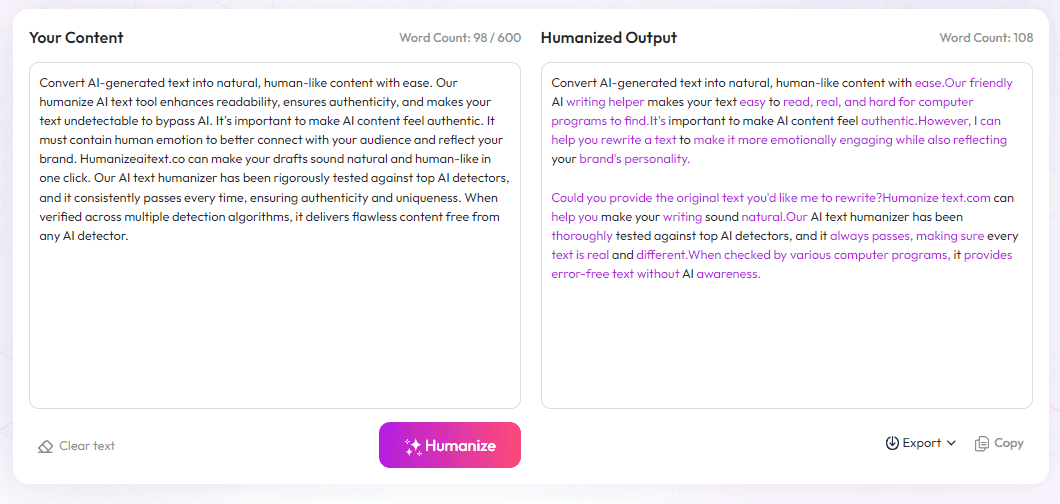Table of Contents
Many people worry about the ethics of using AI in writing, wondering if it might do more harm than good. That's a valid concern, and it’s crucial to handle AI responsibly to keep trust and credibility intact. Stick with me, and I’ll share straightforward ways to use AI ethically, making sure your work stays honest and transparent.
If you keep reading, you'll learn practical tips to stay accountable, protect privacy, and be clear about when AI is helping you. These steps will help you USE AI thoughtfully without losing your human touch, all while keeping your writing trustworthy and respectful.
Here's a quick look at what we'll cover: setting rules for AI use, staying transparent, reviewing outputs for bias, and making sure your work remains human-led and credible. Let's dive into how you can be a responsible AI user in your writing!
Key Takeaways
Key Takeaways
- Use AI honestly by being transparent about its role in your work to keep trust and credibility. Always review AI outputs for accuracy and fairness.
- Avoid sharing sensitive data with AI tools and stay informed about laws and guidelines to prevent legal issues. Properly disclose AI use when publishing.
- Check AI-generated content for biases and stereotypes, and use diverse sources to ensure fairness. Always question if outputs favor certain groups.
- Set clear policies for AI use in your organization, train your team on responsible practices, and regularly review these rules to stay updated.
- Implement tools that monitor AI outputs for bias and accuracy, and require human review before publishing to prevent mistakes and misuse.
- Build an open culture by sharing how AI is used, encouraging feedback, and being transparent about limitations to foster trust with your audience.
- Keep records of AI use, decisions made, and edits to show accountability and identify areas for improvement over time.
- Stay aware of changing regulations and best practices by following relevant organizations and participating in discussions to ensure ethical use.

Using AI responsibly in writing isn't just about avoiding trouble—it's about maintaining integrity, credibility, and respect for your audience. **Ethical AI use means being transparent about how tools influence your work and ensuring your content is accurate and fair.** For example, disclosing that AI helped generate parts of a report or article shows honesty and builds trust with readers. When authors keep accountability for AI-generated content—checking facts, editing outputs, and avoiding plagiarism—they protect their reputation and uphold professional standards. In fact, 30% of academic content produced by AI in the U.S. highlights the importance of verifying AI outputs to prevent misinformation. Moreover, with 68% of teachers using AI detection tools to catch dishonest work, using AI unethically can lead to serious academic consequences. Responsible AI use also involves handling data carefully—never input sensitive or unpublished material, especially since privacy breaches can occur. Being clear about your AI involvement—such as including a statement in your publishing disclosures—promotes transparency and aligns with global standards like UNESCO’s (https://automateed.com/about-the-author-examples-for-students/).
In the workplace, 68% of business leaders believe unauthorized AI use by employees is unethical, emphasizing that permission and oversight are key. Using AI as a tool to support your human creativity, rather than replace it, helps maintain originality and authenticity. For instance, AI can brainstorm ideas or assist with editing, but the core message should come from you. Always verify facts provided by AI—don't let it do all the work—since misinformation can easily sneak in, damaging your credibility and leading to potential legal issues. Learning how to select privacy-focused AI tools and understanding their impact on your work can further help maintain ethical standards. For example, choosing AI that respects data privacy settings and clearly explains its processes helps you stay transparent. If you're unsure how to navigate this, consider consulting guidelines on responsible AI use or (https://automateed.com/how-to-write-a-foreword/). As AI continues to develop, promoting education and ongoing vigilance in responsible use is essential, ensuring these tools remain allies rather than threats in your writing journey.

18. Recognize and address biases in AI outputs to ensure fairness
AI models can unintentionally produce biased content because they learn from existing data, which may include prejudiced patterns.
It's crucial to review AI-generated material for bias, stereotypes, or offensive language before publishing.
Practicing diverse data input and being aware of potential biases can help mitigate unfair representation.
Ask yourself if the AI's suggestions favor certain groups or perspectives, and adjust accordingly.
Using multiple sources and perspectives to fact-check and cross-verify AI outputs can improve fairness and credibility.
19. Understand the legal implications of using AI in writing
Using AI tools can raise legal questions related to copyright, intellectual property, and liability.
Some AI-generated content might infringe on existing copyrighted works if not properly checked.
Disclosing AI involvement and following licensing agreements are vital to avoid legal trouble.
Being aware of regional laws concerning AI and data privacy helps you stay compliant.
Consulting legal experts or trusted guidelines can prevent potential lawsuits or penalties related to AI content use.
20. Stay updated on evolving AI regulations and best practices
AI ethics and regulations are changing rapidly, with new standards emerging around responsible use.
Following updates from organizations like UNESCO or national regulatory bodies helps you stay compliant.
Joining professional groups and forums can provide insights into the latest legal and ethical trends.
Regularly review your AI practices to ensure they align with current standards and avoid unintentional misconduct.
Educating yourself and your team about recent developments promotes a culture of responsible AI use.
21. Foster a culture of transparency within your organization or community
Open communication about AI use builds trust with your audience, colleagues, and clients.
Share how AI tools are integrated into your workflow and their limits openly.
Encourage team discussions on ethical concerns and best practices regarding AI-generated content.
Document policies that specify AI involvement, review processes, and accountability measures.
This transparency not only avoids misunderstandings but also demonstrates your commitment to responsible use.
22. Use responsible AI policies and guidelines to shape your workflow
Creating clear policies ensures everyone understands the dos and don'ts of AI use in your projects.
Align these policies with international standards like the UNESCO recommendation or local regulations.
Include rules for data handling, disclosure requirements, bias mitigation, and content verification.
Train your team on these policies to embed responsible practices into daily work.
Regularly review and update policies to reflect new challenges or technological changes.
23. Implement technical safeguards to ensure ethical AI operation
Technical measures like bias detection tools, content filters, and audit logs help maintain ethical standards.
Utilize AI monitoring systems to flag flagged or problematic outputs automatically.
Set up workflows that require human review before publishing any AI-generated content.
Choosing AI tools with transparent models and explainability features increases control over outputs.
These safeguards act as checks and balances, preventing misuse or unintended harm.
24. Build awareness and consensus on ethical AI use among your audience and community
Educating your readers and stakeholders about responsible AI helps foster trust and accountability.
Share insights on how AI is used in your work and the steps you take to ensure fairness and transparency.
Encourage feedback and discussions on ethical concerns or improvements.
Promoting an environment of openness can lead to better practices and shared responsibility.
Highlighting your commitment to ethics reassures your audience that their interests are protected.
25. Track and document your AI use to improve accountability
Keeping records of when and how you use AI tools helps demonstrate responsible practice.
Document decisions made based on AI outputs, including corrections and human edits.
Maintaining logs can be useful if questions about bias, bias, or ethical lapses arise later.
Reviewing these records periodically can reveal patterns and areas for improvement.
This practice supports transparency and shows that you're proactive about ethical considerations.
FAQs
Ethical use of AI ensures that content is fair, unbiased, and respects intellectual property. It helps maintain trust with readers and prevents harm caused by misinformation or misuse of AI-generated material.
Authors should review, verify, and edit AI outputs, clearly disclose AI involvement, and ensure the information aligns with factual accuracy and ethical standards in their work.
Transparency involves openly disclosing when and how AI tools are used in content creation, helping maintain credibility and allowing readers to understand the role of AI in your work.
Use AI tools that prioritize data privacy, avoid sharing sensitive or unpublished information, and follow best practices for data security to protect privacy rights and prevent data misuse.



